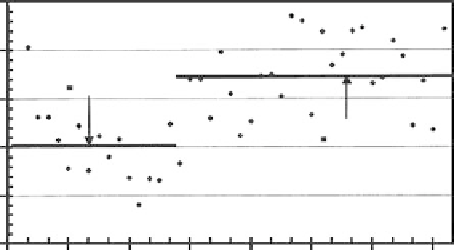Agriculture Reference
In-Depth Information
250
200
Mean before 1970
102 mm
150
Mean after 1970
173 mm
100
50
0
54
60
66
72
78
84
90
96
YEAR
fIguRe 19.3
Average annual volumetric soil water content at planting time for dry-
land grain sorghum in studies conducted from 1956 to 1997 at the U.S. Department of
Agriculture
'
s Agriculture Research Service (USDA-ARS) Conservation and Production
Research Laboratory, Bushland, Texas. (From P.W. Unger and R.L. Baumhardt, 1999,
Agronomy Journal
91:870
-
875.)
and increased soil water storage. The stored water supplemented the growing season
precipitation and increased the amount of annual precipitation that could be used for
evapotranspiration. As discussed regarding Figure 19.1, there is a direct relationship
between the amount of water used by a crop for evapotranspiration and the agro-
nomic yield.
Stone and Schlegel (2006) also showed that the amount of stored water present
in the soil profile at time of seeding either grain sorghum or wheat under semiarid
conditions in western Kansas directly affected grain yields. Less tillage and more
plant residues remaining on the soil surface increased the percentage of precipita-
tion occurring between crops stored in the soil profile that could be used by the
subsequent crop. This in turn increased the amount of annual precipitation used for
evapotranspiration and increased precipitation use efficiency.
D
e C r e a s i n g
t h e
e
v a P o r a it i o n
P
of r t i of n
o f
e
v a P of t r a n s P i r a t i of n
As defined, evapotranspiration is the sum of the water transpired by the crop and that
evaporated from the soil between the time the crop is planted and is harvested. The
amount of evapotranspiration can be determined relatively accurately by research-
ers, but it is much more difficult to measure evaporation and transpiration separately.
However, it is well understood by the relationships shown in Figure 19.1 that the
greater the amount of evapotranspiration that is used for transpiration, the greater
the water use efficiency is because plant growth and yield are directly associated
with transpiration.
Any management practice that increases the transpiration portion of evapotrans-
piration will increase the water use efficiency. Early in the growing season, when the
amount of leaf area is small, the amount of water transpired by the plants is relatively

